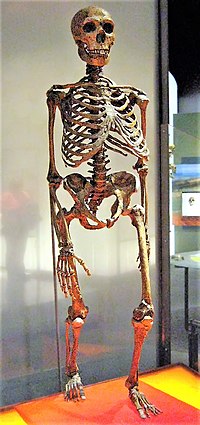Search results
Appearance
There is a page named "Amud 1" on Wikipedia
- Amud 1 is a nearly complete but poorly preserved adult Southwest Asian Neanderthal skeleton thought to be about 55,000 years old. It was discovered at...8 KB (835 words) - 05:23, 9 March 2024
- Nahal Amud (Hebrew: נחל עמוד), also known as the Wadi al-Amud, is a stream in the Upper Galilee region of Israel that flows into the Sea of Galilee. The...4 KB (351 words) - 06:52, 2 July 2024
- Amud or Amoud (Somali: Camuud, Somali pronunciation: [ʕamuːd], عمود, Arabic: عمود) is an ancient, ruined town in the Awdal region of Somaliland. Named...14 KB (1,675 words) - 04:32, 1 June 2024
- Amud Cave is located in the Upper Galilee, in the Nahal Amud gorge. It is situated about 30 m (98 ft) above Nahal Amud, right next to and above the famous...3 KB (241 words) - 22:51, 15 September 2023
- decreased since the Upper Palaeolithic. The largest Neanderthal brain, Amud 1, was calculated to be 1,736 cm3 (105.9 cu in), one of the largest ever recorded...332 KB (36,029 words) - 18:08, 30 June 2024
- 1641 cm3, it is the second largest hominid skull ever discovered, after Amud 1. The skull displays many of the "classic" examples of Neanderthal anatomy...9 KB (1,125 words) - 21:38, 30 June 2024
- ramus [of Amud 1] goes down far behind M3, and runs into the low prominentia lateralis below the distal part of M3. For this reason, when the Amud mandible...3 KB (342 words) - 21:07, 1 February 2024
- ; Suzuki, H.; et al. (2015). "Virtual Reconstruction of the Neanderthal Amud 1 Cranium" (PDF). American Journal of Physical Anthropology. 158 (2): 185–197...71 KB (8,640 words) - 22:30, 29 June 2024
- and was initially reported to comprise 1 to 4 percent of the genome. This fraction was refined to 1.5 to 2.1 percent. Further analyses have found that...31 KB (3,236 words) - 06:02, 13 May 2024
- to Produce Creativity and Innovation". Creativity Research Journal. 19 (1): 1–18. doi:10.1080/10400410709336873. S2CID 15247122. Balsters, Joshua H; Whelan...46 KB (5,128 words) - 04:09, 26 June 2024
- modernhumanorigins.net/amud1.html Archived 2011-04-24 at the Wayback Machine Amud 1 Image at Modern Human Origins "Human evolution: interpreting evidence"....118 KB (7,280 words) - 03:41, 2 July 2024
- Lagar Velho 1, also known as the Lagar Velho boy or Lapedo child, is a complete prehistorical skeleton found in Portugal, believed to be a hybrid that...4 KB (446 words) - 08:41, 27 May 2024
- Shanidar 1)Iraq. Neanderthal remains were discovered here in 1953, including Shanidar 1, who survived several injuries, possibly due to care from others in his group...39 KB (4,678 words) - 00:12, 5 June 2024
- Culturali e Paesaggistici della Puglia. Archived from the original on October 1, 2018. Retrieved September 3, 2016. "Three-Dimensional Topographic Survey...12 KB (1,224 words) - 04:22, 30 June 2024
- as Neanderthals. Amud I, the skeleton of an adult male was found at the top of layer B1, while the partial skeleton of the baby Amud 7 (Rak, Kimbet &...8 KB (1,833 words) - 22:23, 9 March 2024
- Bab el-Amud)al-Naṣr (باب النصر) means "gate of victory", and the current one, Bāb al-ʿĀmūd (باب العامود), means "gate of the column". The latter, in use continuously...18 KB (1,847 words) - 07:09, 22 April 2024Chapelle-aux-Saints 1 'Old Man'), the femur (La Ferrassie 1), fibulae (La Ferrassie 2 and Tabun 1), spine (Kebara 2) and skull (Shanidar I, Krapina, Sala 1). These...35 KB (4,155 words) - 13:50, 23 June 2024300 cm3 (79 cu in)), with a range extending up to 1,736 cm3 (105.9 cu in) (Amud 1). "Based on 45 long bones from maximally 14 males and 7 females, Neanderthals'...114 KB (12,460 words) - 21:06, 30 June 2024
- The site of the sacred oak has been sought at two places: one called El-’Amūd, “the column”—where is “Joseph's tomb”; and the other at Balāta (a name containing
- Exalted is He, created him as a light within a column of light (nūran fī ʿamūd al-nūr), a million years before creation, with the essential characteristics
- Neanderthal fossils have been found in Israel at several sites: Kebara, Tabun, and Amud. For many years there were no reliable absolute dates. Recently, these sites
)











